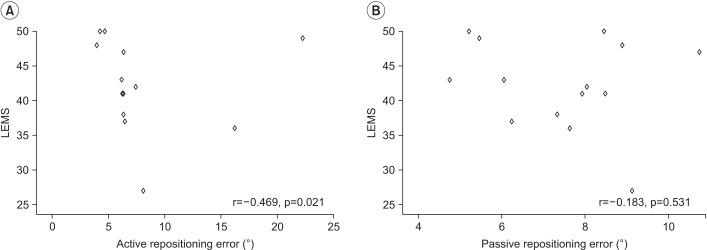Ann Rehabil Med.
2017 Apr;41(2):218-224. 10.5535/arm.2017.41.2.218.
Quantitative Assessment of Proprioception Using Dynamometer in Incomplete Spinal Cord Injury Patients: A Preliminary Study
- Affiliations
-
- 1Department of Rehabilitation Medicine, Seoul National University Hospital, Seoul, Korea. keewonkimm.d@gmail.com
- KMID: 2389479
- DOI: http://doi.org/10.5535/arm.2017.41.2.218
Abstract
OBJECTIVE
To investigate the feasibility of a knee proprioception evaluation using a dynamometer as a tool for evaluating proprioception of the lower extremities in patients with incomplete spinal cord injury (SCI), and to explore its usefulness in predicting the ambulatory outcome.
METHODS
A total of 14 SCI patients (10 tetraplegic, 4 paraplegic; all AIS D) were included in this study. The passive repositioning error (PRE) and active repositioning error (ARE) were measured with a dynamometer, along with tibial somatosensory evoked potential (SSEP) and abductor hallucis motor-evoked potential (MEP). Ambulatory capacity was assessed with the Walking Index for Spinal Cord Injury II (WISCI-II), both at the time of the proprioception test (WISCI_i) and at least 6 months after the test (WISCI_6mo).
RESULTS
The PRE showed a negative correlation with WISCI_i (r=-0.440, p=0.034) and WISCI_6mo (r=-0.568, p=0.010). Linear multiple regression showed the type of injury, lower extremities motor score, MEP, and PRE accounted for 75.4% of the WISCI_6mo variance (p=0.080).
CONCLUSION
Proprioception of the knee can be measured quantitatively with a dynamometer in patients with incomplete SCI, and PRE was related to the outcome of the ambulatory capacity. Along with the neurological and electrophysiological examinations, a proprioception test using a dynamometer may have supplementary value in predicting the ambulatory capacity in patients with incomplete SCI.
Keyword
MeSH Terms
Figure
Reference
-
1. Curt A, Keck ME, Dietz V. Functional outcome following spinal cord injury: significance of motor-evoked potentials and ASIA scores. Arch Phys Med Rehabil. 1998; 79:81–86. PMID: 9440423.
Article2. Curt A, Dietz V. Ambulatory capacity in spinal cord injury: significance of somatosensory evoked potentials and ASIA protocol in predicting outcome. Arch Phys Med Rehabil. 1997; 78:39–43. PMID: 9014955.
Article3. Waters RL, Adkins RH, Yakura JS, Sie I. Motor and sensory recovery following incomplete tetraplegia. Arch Phys Med Rehabil. 1994; 75:306–311. PMID: 8129584.
Article4. Burns SP, Golding DG, Rolle WA Jr, Graziani V, Ditunno JF Jr. Recovery of ambulation in motor-incomplete tetraplegia. Arch Phys Med Rehabil. 1997; 78:1169–1172. PMID: 9365343.
Article5. Oleson CV, Burns AS, Ditunno JF, Geisler FH, Coleman WP. Prognostic value of pinprick preservation in motor complete, sensory incomplete spinal cord injury. Arch Phys Med Rehabil. 2005; 86:988–992. PMID: 15895346.
Article6. Waters RL, Adkins R, Yakura J, Vigil D. Prediction of ambulatory performance based on motor scores derived from standards of the American Spinal Injury Association. Arch Phys Med Rehabil. 1994; 75:756–760. PMID: 8024420.
Article7. Van Middendorp JJ, Hosman AJ, Pouw MH. EM-SCI Study Group. Van de Meent H. ASIA impairment scale conversion in traumatic SCI: is it related with the ability to walk? A descriptive comparison with functional ambulation outcome measures in 273 patients. Spinal Cord. 2009; 47:555–560. PMID: 19104512.
Article8. Curt A, Dietz V. Electrophysiological recordings in patients with spinal cord injury: significance for predicting outcome. Spinal Cord. 1999; 37:157–165. PMID: 10213324.
Article9. Pai YC, Rymer WZ, Chang RW, Sharma L. Effect of age and osteoarthritis on knee proprioception. Arthritis Rheum. 1997; 40:2260–2265. PMID: 9416866.
Article10. Barrett DS, Cobb AG, Bentley G. Joint proprioception in normal, osteoarthritic and replaced knees. J Bone Joint Surg Br. 1991; 73:53–56. PMID: 1991775.
Article11. Nagai T, Sell TC, Abt JP, Lephart SM. Reliability, precision, and gender differences in knee internal/external rotation proprioception measurements. Phys Ther Sport. 2012; 13:233–237. PMID: 23068898.
Article12. Drouin JM, Valovich-mcLeod TC, Shultz SJ, Gansneder BM, Perrin DH. Eur J Appl Physiol. 2004; 91:22–29. PMID: 14508689.13. Kirshblum SC, Burns SP, Biering-Sorensen F, Donovan W, Graves DE, Jha A, et al. International standards for neurological classification of spinal cord injury (revised 2011). J Spinal Cord Med. 2011; 34:535–546. PMID: 22330108.
Article14. DeLisa JA, MacKenzie K, Baran EM. Manual of nerve conduction velocity and somatosensory evoked potentials. 2nd ed. New York: Raven Press;1987.15. Di Lazzaro V, Oliviero A, Profice P, Ferrara L, Saturno E, Pilato F, et al. The diagnostic value of motor evoked potentials. Clin Neurophysiol. 1999; 110:1297–1307. PMID: 10423196.
Article16. Dittuno PL, Ditunno JF Jr. Walking index for spinal cord injury (WISCI II): scale revision. Spinal Cord. 2001; 39:654–656. PMID: 11781863.
Article17. Lephart SM, Pincivero DM, Rozzi SL. Proprioception of the ankle and knee. Sports Med. 1998; 25:149–155. PMID: 9554026.
Article18. Riskowski JL, Mikesky AE, Bahamonde RE, Alvey TV 3rd, Burr DB. Proprioception, gait kinematics, and rate of loading during walking: are they related? J Musculoskelet Neuronal Interact. 2005; 5:379–387. PMID: 16340143.19. Amatachaya S, Amatachaya P, Keawsutthi M, Siritaratiwat W. External cues benefit walking ability of ambulatory patients with spinal cord injury. J Spinal Cord Med. 2013; 36:638–644. PMID: 24090447.
Article20. Bayramoglu M, Toprak R, Sozay S. Effects of osteoarthritis and fatigue on proprioception of the knee joint. Arch Phys Med Rehabil. 2007; 88:346–350. PMID: 17321828.
Article21. Yang JM, Kim SY. Correlation of knee proprioception with muscle strength and spasticity in stroke patients. J Phys Ther Sci. 2015; 27:2705–2708. PMID: 26504273.
Article22. Arockiaraj J, Korula RJ, Oommen AT, Devasahayam S, Wankhar S, Velkumar S, et al. Proprioceptive changes in the contralateral knee joint following anterior cruciate injury. Bone Joint J. 2013; 95-B:188–191. PMID: 23365027.
Article
- Full Text Links
- Actions
-
Cited
- CITED
-
- Close
- Share
- Similar articles
-
- Measurement of Proprioception of the Knee in Hemiplegic Patients Using an Isokinetic Dynamometer
- The Significance of Space Available for the Spinal cord at the Injured Level in the Lower Cervical Spine Fractures and Dislocations
- Clinical Value of the Somatosensory Evoked Potential in Spinal Cord Injuries
- Serum hormone and testicular histologic changes in spinal cord injured men
- Nerve injury in an undiagnosed adult tethered cord syndrome patients following spinal anesthesia: A case report



